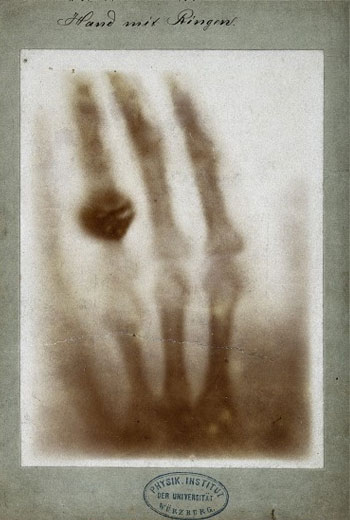Good morning, Whitewater
Our Saturday will be partly sunny with a high of forty. Sunrise is 6:39 AM and sunset 4:38 PM. We’ll have 9h 59m 15s of daytime, and the moon is in a waning gibbous phase.

Hand with Rings: a print of one of the first of Wilhelm Röntgen’s X-ray photographs. It shows the left hand of his wife, Anna Bertha Ludwig, and was presented to Professor Ludwig Zehnder of the Physik Institut, University of Freiburg, on 1 January 1896.
Source: National Aeronautics and Space Administration (NASA)
Public domain via Wikimedia Commons
Photographer: Wilhelm Röntgen
On this day in 1895, Wilhelm Röntgen first observes X-rays:
Wilhelm Conrad Röntgen…27 March 1845 – 10 February 1923) was a German physicist, who, on 8 November 1895, produced and detected electromagnetic radiation in a wavelength range today that was known as X-rays or Röntgen rays, an achievement that earned him the first Nobel Prize in Physics in 1901.[1] In honour of his accomplishments, in 2004 the International Union of Pure and Applied Chemistry (IUPAC) named element 111, roentgenium, a radioactive element with multiple unstable isotopes, after him.
In the late afternoon of 8 November 1895, Röntgen was determined to test his idea [about a fluorescent effect]. He carefully constructed a black cardboard covering similar to the one he had used on the Lenard tube. He covered the Hittorf-Crookes tube with the cardboard and attached electrodes to a Ruhmkorff coil to generate an electrostatic charge. Before setting up the barium platinocyanide screen to test his idea, Röntgen darkened the room to test the opacity of his cardboard cover. As he passed the Ruhmkorff coil charge through the tube, he determined that the cover was light-tight and turned to prepare the next step of the experiment. It was at this point that Röntgen noticed a faint shimmering from a bench a few feet away from the tube. To be sure, he tried several more discharges and saw the same shimmering each time. Striking a match, he discovered the shimmering had come from the location of the barium platinocyanide screen he had been intending to use next.
Röntgen speculated that a new kind of ray might be responsible. 8 November was a Friday, so he took advantage of the weekend to repeat his experiments and make his first notes. In the following weeks he ate and slept in his laboratory as he investigated many properties of the new rays he temporarily termed “X-rays”, using the mathematical designation for something unknown. The new rays came to bear his name in many languages as “Röntgen Rays” (and the associated X-ray radiograms as “Röntgenograms”).
